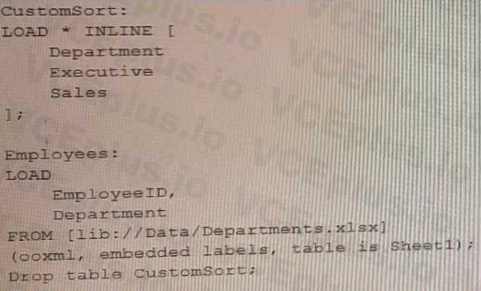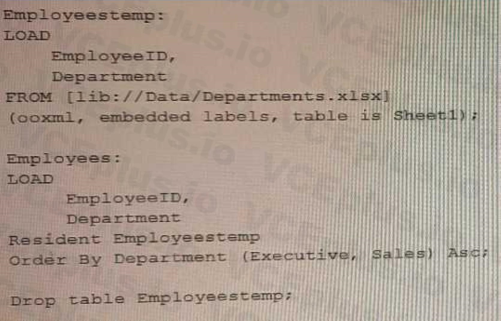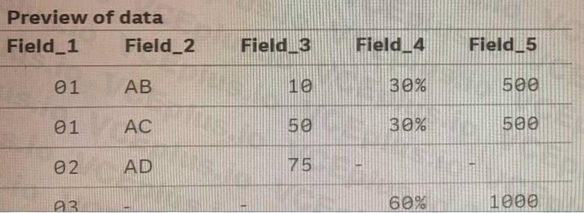File Info
| Exam | Qlik Sense Data Architect Certification |
| Number | QSDA2022 |
| File Name | QlikView.QSDA2022.VCEplus.2023-05-20.77q.vcex |
| Size | 17 MB |
| Posted | May 20, 2023 |
| Download | QlikView.QSDA2022.VCEplus.2023-05-20.77q.vcex |
How to open VCEX & EXAM Files?
Files with VCEX & EXAM extensions can be opened by ProfExam Simulator.
Coupon: MASTEREXAM
With discount: 20%





Demo Questions
Question 1

A data architect needs to develop a script to export tables from a model based upon rules from an independent file. The structure of the text file with the export rules is as follows:

These rules govern which table in the model to export, what the target root filename should be, and the number of copies to export.
The TableToExport values are already verified to exist in the model.
In addition, the format will always be QVD, and the copies will be incrementally numbered.
For example, the Customer table would be exported as:
What is the minimum set of scripting strategies the data architect must use?
- Two loops without any conditional statement
- One loop and two IF statements
- Two loops and one IF statement
- One loop and one SELECT CASE statement
Correct answer: D
Explanation:
The data architect will need to use a single loop to iterate through the rows of the independent file containing the export rules. Within the loop, they will need to use a SELECT CASE statement to determine which table in the model to export based on the TableToExport value in the current row of the independent file. They can then use the StoreAsFilename value to determine the target root filename, and the NumberOfCopies value to determine the number of copies to export.This approach makes use of a single loop to iterate through the rows of the independent file, and a SELECT CASE statement to determine which table to export based on the TableToExport value in the current row. It is the most efficient way to accomplish the task with minimal scripting.You can find the Qlik scripting documentation for Store statement here:https://help.qlik.com/en-US/sense/June2020/Subsystems/Hub/Content/Scripting/ScriptPrefixes/Store.htm and SELECT CASEstatement here:https://help.qlik.com/en-US/sense/June2020/Subsystems/Hub/Content/Scripting/ScriptStatements/Select.htm The data architect will need to use a single loop to iterate through the rows of the independent file containing the export rules. Within the loop, they will need to use a SELECT CASE statement to determine which table in the model to export based on the TableToExport value in the current row of the independent file. They can then use the StoreAsFilename value to determine the target root filename, and the NumberOfCopies value to determine the number of copies to export.
This approach makes use of a single loop to iterate through the rows of the independent file, and a SELECT CASE statement to determine which table to export based on the TableToExport value in the current row. It is the most efficient way to accomplish the task with minimal scripting.
You can find the Qlik scripting documentation for Store statement here:https://help.qlik.com/en-US/sense/June2020/Subsystems/Hub/Content/Scripting/ScriptPrefixes/Store.htm and SELECT CASEstatement here:
https://help.qlik.com/en-US/sense/June2020/Subsystems/Hub/Content/Scripting/ScriptStatements/Select.htm
Question 2
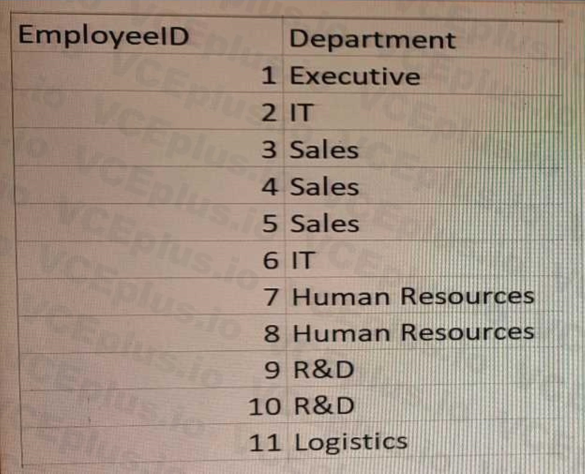

A company has different departments. Executive and Sales should always be the first values in a Department filter pane. Which script must the data architect use to meet this requirement?
Correct answer: D
Question 3

A data architect executes the following script.

Which values does the OrderDate field contain after executing the script?
- 20210131, 2020/01/31, 31/01/2019, 0
- 20210131,2020/01/31,31/01/2019
- 20210131, 2020/01/31, 31/01/2019, 9999
- 20210131, 2020/01/31, 31/01/2019, 31/12/20
Correct answer: D
Question 4


Refer to the exhibit
A data architect is working on an app that contains orders, invoices, and shipping dat a. There are three different date fields within the data:
- OrderDate
- InvoiceDate
- ShippingDate
The business analyst needs to replicate the chart above to show Order and Shipping amounts on the same Month axis.
What should the data architect do?
- Create a Month field for each of the three dates in the fact table and use that in the chart
- Load the key field and the three date fields into a concatenated bridge table that contains KeyField and Date
- Left Join the three date fields onto one bridge table using the key field containing KeyField and Date
Correct answer: B
Question 5
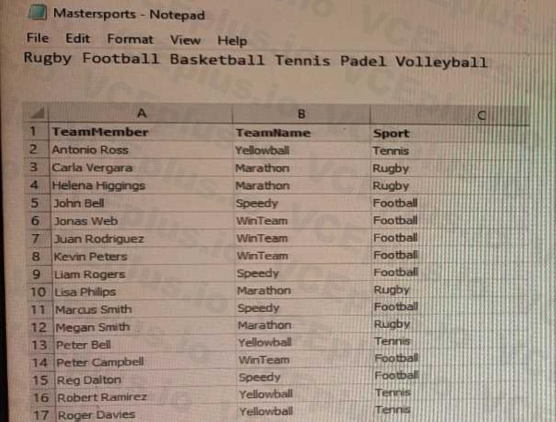

Refer to the exhibits.
The first table, Mastersports, contains the master list of all sport names that need to be loaded into the app. The second table, TeamMembers, contains the teams and team members registered for specific sports.
In a Qlik Sense app, a data architect is loading the two tables that need to be linked together based on the Sport field. The table format cannot be changed in the source.
What should the data architect do in the data load editor?
- Apply a preceding LOAD from the TeamMembers table with the SUBFIELD function and rename the field to Sport
- Apply a preceding LOAD to the MasterSports table with the SUBFIELD function to create the Sport field
- Apply a FOR loop to load to the MasterSports table creating the values for the Sport field
Correct answer: C
Question 6
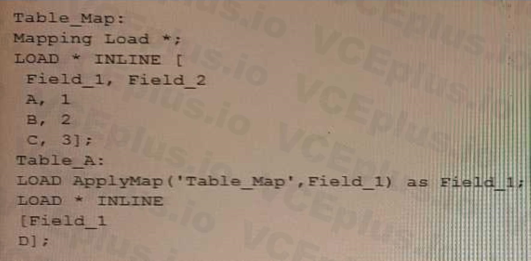
Refer to the exhibit.

A data architect executes the script.
What will be the value of the first row for Field_1?
- A
- D
- Null
- 4
Correct answer: B
Question 7
A data architect is building a model to show trends in visualizations across seven date fields. The seven date fields reside in different tables. The data architect must efficiently build this data model.
Requirements:
- A single date selector
- Show all dates, even those with NO activity
- Minimize the impact on server resources and p
Which two solutions should the data architect use? (Select two.)
- Canonical calendar
- Generic load
- Data island
- Multiple calendars
- Link table
Correct answer: AE
Explanation:
A canonical calendar should be used to create a single date selector that can be used to show all dates, even those with no activity. A link table should be used to join the seven date fields from different tables, which will minimize the impact on server resources and performance. Source: Qlik A canonical calendar should be used to create a single date selector that can be used to show all dates, even those with no activity. A link table should be used to join the seven date fields from different tables, which will minimize the impact on server resources and performance. Source: Qlik
Question 8
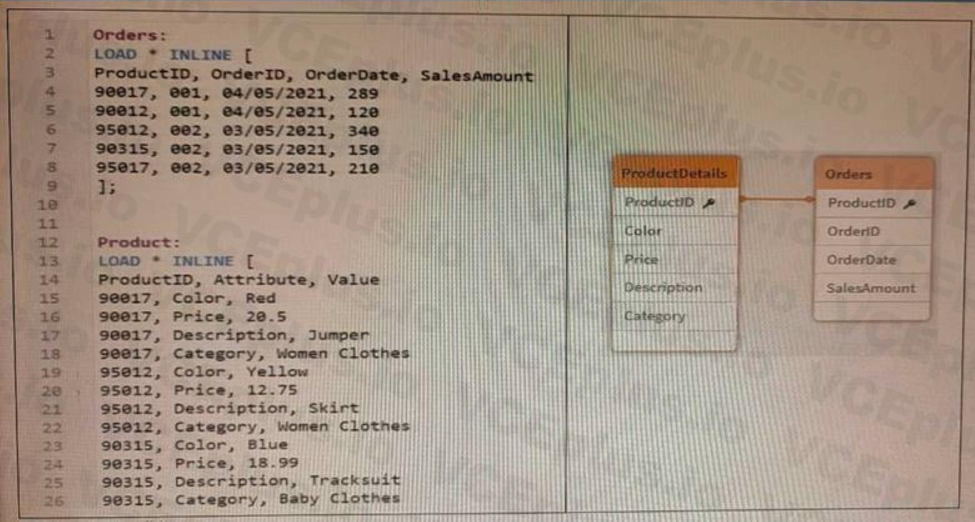
Refer to the exhibit.

A data architect is loading two tables: Orders and Product. The Product table includes attributes and values for each ProductID such as Colour, Price, Category, and Description.
The business analyst can filter by the value of these attributes. For performance reasons, the Data Model will use two tables.
Which solution should the data architect apply in the Data Load Editor to build the ProductDetails table?
For performance reasons, the Data Model will use two tables a Load Editor to build the ProductDetails table?
- Use a For loop to concatenate all of the Products table and apply a Generic Load to the final concatenate table
- Use a For loop to apply a Generic load to the Product table and concatenate the generic tables together
- Use a Generic Load in the Product table and a For loop to left join each Generic table
Correct answer: C
Question 9
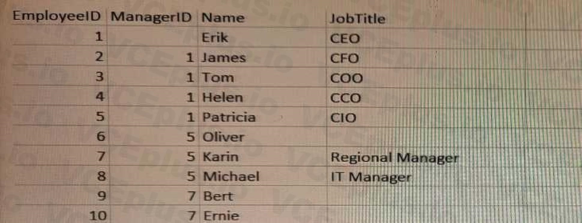
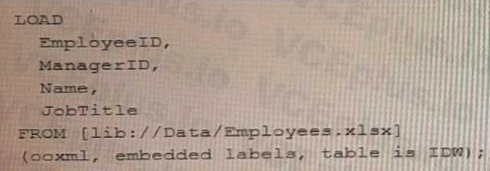

A Human Resources Director needs an app to analyze organizational structure. The Directory is particularly interested in the longest levels of line management.
Two table loads are required. Both use the same basic structure.

Which two table load prefixes are needed?
- HierarchyLevel(EmployeelD, ManagerlD Name Level, '/', Structure) HierarchyBelongsTo(EmployeelD, ManagerlD, Name ManagerlD, Manager, Depth)
- HierarchyBelongsTo(ManagerlD, Manager, ManagerlD, ManagerlD, Manager Level) Hierarchy(EmployeelD, ManagerlD, Name. Manager Name, Structure ‘/’ Depth)
- Hierarchy(EmployeelD. ManagerlD Name, Manager Name, Structure V, Depth) HierarchyLevelEmployeelD, ManagerlD, Name, Manager, Name, Structure, Depth ‘/')
- HierarchyBelongs.To(EmployeeID, ManagerlD, Name ManagerlD, Manager, Depth)
Correct answer: D
Question 10
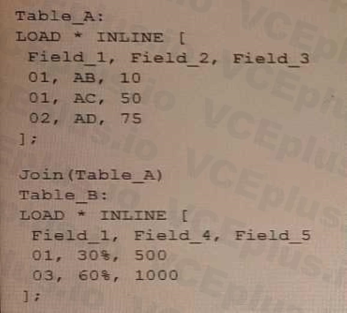
A data architect executes the following script:

What will be the result of Table A?
Correct answer: D

